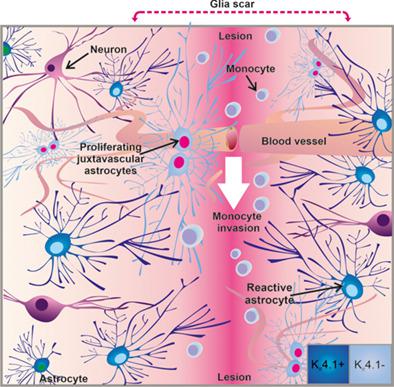Our official English website, www.x-mol.net, welcomes your feedback! (Note: you will need to create a separate account there.)
Heterogeneity of astrocytes: Electrophysiological properties of juxtavascular astrocytes before and after brain injury.
Glia ( IF 6.2 ) Pub Date : 2020-08-18 , DOI: 10.1002/glia.23900 Stefanie Götz 1, 2, 3 , Ana Bribian 4 , Laura López-Mascaraque 4 , Magdalena Götz 3, 5, 6 , Benedikt Grothe 1, 3 , Lars Kunz 1
Glia ( IF 6.2 ) Pub Date : 2020-08-18 , DOI: 10.1002/glia.23900 Stefanie Götz 1, 2, 3 , Ana Bribian 4 , Laura López-Mascaraque 4 , Magdalena Götz 3, 5, 6 , Benedikt Grothe 1, 3 , Lars Kunz 1
Affiliation

|
Astrocyte heterogeneity is increasingly recognized, but still little is known about juxtavascular astrocytes with their somata directly adjacent to blood vessels, despite their importance after brain injury. As juxtavascular astrocytes originate from common progenitor cells, that is, have a clonal origin, they may intrinsically differ from other, non‐juxtavascular astrocytes. To explore this, we examined the electrophysiological properties of these groups of astrocytes and the underlying ion channels. Using brain slices of BAC Aldh1l1‐eGFP transgenic mice with astrocytes labeled by GFP expression, we compared juxtavascular and non‐juxtavascular astrocytes in the somatosensory cortex by means of whole‐cell patch‐clamp recordings and immunohistochemical staining. Prior to injury, juxta‐ and non‐juxtavascular astrocytes exhibit comparable electrophysiological properties with characteristic mostly passive conductance and a typical negative resting membrane potential. Immunohistochemical analysis of K+ channels showed that all astrocytes were Kir4.1+, but revealed an intriguing difference for Kv4.3. The expression of Kv4.3 in sibling astrocytes (non‐juxtavascular, juxtavascular and pial) was dependent on their ontogenetic origin with lowest levels in juxtavascular astrocytes located in upper cortical layers. After traumatic brain injury (TBI), we found profound changes in the electrophysiological type of astrocytes with a predominance of non‐passive properties and this pattern was significantly enriched in juxtavascular astrocytes. This was accompanied by pronounced down‐regulation of Kir4.1 in proliferating astrocytes, which was significantly more in juxtavascular compared to non‐juxtavascular astrocytes. Taken together, TBI induces profound differences in electrophysiological properties between juxtavascular and non‐juxtavascular astrocytes that might be related to the preponderance of juxtavascular astrocyte proliferation.
中文翻译:

星形胶质细胞的异质性:脑损伤前后并列星形胶质细胞的电生理特性。
星形胶质细胞的异质性越来越得到认可,但对于其胞体直接与血管相邻的近血管星形胶质细胞知之甚少,尽管它们在脑损伤后很重要。由于血管旁星形胶质细胞起源于共同的祖细胞,即具有克隆起源,因此它们可能在本质上不同于其他非血管旁星形胶质细胞。为了探索这一点,我们检查了这些星形胶质细胞群和潜在离子通道的电生理特性。使用带有 GFP 表达标记的星形胶质细胞的 BAC Aldh1l1-eGFP 转基因小鼠的脑切片,我们通过全细胞膜片钳记录和免疫组织化学染色比较了体感皮层中的近血管和非近血管星形胶质细胞。受伤前,并列和非并列的星形胶质细胞表现出相当的电生理特性,具有特征性的主要是被动电导和典型的负静息膜电位。K的免疫组织化学分析+通道显示所有星形胶质细胞都是 K ir 4.1 + ,但揭示了 K v 4.3的有趣差异。K v 4.3 在兄弟星形胶质细胞(非近血管、近血管和软脑膜)中的表达取决于它们的个体发育起源,在位于上皮层的近血管星形胶质细胞中水平最低。在创伤性脑损伤 (TBI) 后,我们发现星形胶质细胞的电生理类型发生了深刻的变化,主要是非被动特性,并且这种模式在血管旁的星形胶质细胞中显着富集。这伴随着K ir的显着下调4.1 在增殖的星形胶质细胞中,与非近血管星形胶质细胞相比,近血管星形胶质细胞明显更多。总之,TBI 在血管旁和非血管旁星形胶质细胞之间引起了电生理特性的巨大差异,这可能与血管旁星形胶质细胞增殖的优势有关。
更新日期:2020-08-18
中文翻译:

星形胶质细胞的异质性:脑损伤前后并列星形胶质细胞的电生理特性。
星形胶质细胞的异质性越来越得到认可,但对于其胞体直接与血管相邻的近血管星形胶质细胞知之甚少,尽管它们在脑损伤后很重要。由于血管旁星形胶质细胞起源于共同的祖细胞,即具有克隆起源,因此它们可能在本质上不同于其他非血管旁星形胶质细胞。为了探索这一点,我们检查了这些星形胶质细胞群和潜在离子通道的电生理特性。使用带有 GFP 表达标记的星形胶质细胞的 BAC Aldh1l1-eGFP 转基因小鼠的脑切片,我们通过全细胞膜片钳记录和免疫组织化学染色比较了体感皮层中的近血管和非近血管星形胶质细胞。受伤前,并列和非并列的星形胶质细胞表现出相当的电生理特性,具有特征性的主要是被动电导和典型的负静息膜电位。K的免疫组织化学分析+通道显示所有星形胶质细胞都是 K ir 4.1 + ,但揭示了 K v 4.3的有趣差异。K v 4.3 在兄弟星形胶质细胞(非近血管、近血管和软脑膜)中的表达取决于它们的个体发育起源,在位于上皮层的近血管星形胶质细胞中水平最低。在创伤性脑损伤 (TBI) 后,我们发现星形胶质细胞的电生理类型发生了深刻的变化,主要是非被动特性,并且这种模式在血管旁的星形胶质细胞中显着富集。这伴随着K ir的显着下调4.1 在增殖的星形胶质细胞中,与非近血管星形胶质细胞相比,近血管星形胶质细胞明显更多。总之,TBI 在血管旁和非血管旁星形胶质细胞之间引起了电生理特性的巨大差异,这可能与血管旁星形胶质细胞增殖的优势有关。



























 京公网安备 11010802027423号
京公网安备 11010802027423号